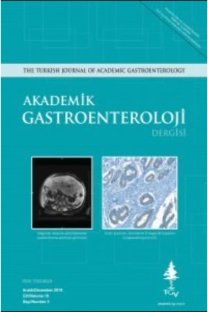Bölgemizde Helicobacter pylori sıklığı
Helicobacter pylori prevalance in our region
___
- 1. Marshall BJ, Warren JR. Unidentified curved bacilli in the stomach of patients with gastritis and peptic ulceration. Lancet 1984;1:1311-5.
- 2. Altintaş E, Ulu O, Sezgin O, et al. Comparison of ranitidine, bismuth citrate, tetracycline and metronidazole with ranitidine, bismuth citrate and azithromycin for the eradication of Helicobacter pylori in patients resistant to PPI based triple therapy. Turk J Gastroenterol 2004;15:90-3.
- 3. Köksal AS, Onder FO, Torun S, et al. Twice a day quadruple therapy for the first-line treatment of Helicobacter pylori in an area with a high prevalence of background antibiotic resistance. Acta Gastroenterol Belg 2013;76:34-7.
- 4. Zheng Q, Chen WJ, Lu H, et al. Comparison of the efficacy of triple versus quadruple therapy on the eradication of Helicobacter pylori and antibiotic resistance. J Dig Dis 2010;11:313-8.
- 5. Brooks GF, Butel JS, Morse SA. Jawetz Melnick and A delberg’s Medical Microbiology. 21st ed. Connecticut: Appelet on and Lange, 1998:543-65.
- 6. Dunn BE, Cohen H, Blaser MJ. Helicobacter pylori. Clin Microbiol Rev 1997;10:720-41.
- 7. [No authors listed]. Schistosomes, liver flukes and Helicobacter pylori. IARC Working Group on the Evaluation of Carcinogenic Risks to Humans. Lyon, 7-14 June 1994. IARC Monogr Eval Carcinog Risks Hum 1994;61:1-241.
- 8. IARC Helicobacter pylori Working Group. Helicobacter Pylori Eradication as a Strategy for Preventing Gasric Cancer. Lyon, France: International Agency for Research on Cancer (IARC Working Group reports, no.8); 2014. Available from: http://www.iare.fr/en/publications/pdfs-online/wrk/wrk8/index.php./Last accessed 2015 Aug2)
- 9. Torre LA, Bray F, Siegel RL, et al. Global cancer statistics, 2012. CA Cancer J Clin 2015;65:87-108.
- 10. Malfertheiner P, Megraud F, O’ Morain CA, Atherton J, Axon AT, Bazzoli F, et al. Management of Helicobacter pylori infection-The Maastricht IV/Florence Consensus Report. Gut 2012; 61:646-64.
- 11. Graham DY, Malaty HM, Evans DG, et all. Epidemiology of Helicobacter pylori in an asymptomatic population in the United States. Effect of age, race, and socioeconomic status. Gastroenterology 1991;100:1495-501.
- 12. Georgopoulos SD, Papastergiou V, Karatapanis S. Current options for the treatment of Helicobacter pylori. Expert Opin Pharmacother 2013;14:211-23.
- 13. Özkan TB. Çocuklarda Helicobacter pylori enfeksiyonunda seroloji, tanı ve tedavi. Uludağ Üni Tıp Fak Derg 2007;33:81-5.
- 14. Moya DA, Crrisinger KD. Helicobacter pylori persistence in children: distinguishing inadequate treatment, resistant organisms, and reinfection. Curr Gastroenterol Rep 2012;14:236-42.
- 15. Fidan I, Türet S. Helicobacter pylori enfeksiyonunda patogenez ve tanı. Enfeksiyon Dergisi 1999;13:455-460.
- 16. Ozaydin N1, Turkyilmaz SA, Cali S. Prevalence and risk factors of Helicobacter pylori in Turkey: a nationally-representative, cross-sectional, screening with the 13C-Urea breath test. BMC Public Health 2013;13:1215.
- 17. Ozden A, Bozdayı G, Ozkan M, Kose KS. Changes in the seroepidemiyological pattern of Helicobacter pylori infection over the last 10 years in Turkey. Turk J Gastroenterol 2004;15:156-8.
- 18. Syam AF, Miftahussurur M, Makmun D, et al. Risk factors and prevalence of Helicobacter pylori in five largest islands of Indonesia: a preliminary study. PLoS One 2015;10:e0140186.
- 19. Açık Y, Gülbayrak C, Dönder E, Yalnız M. Fırat Tıp Merkezine dispeptik yakınmalarla başvuran hastalarda Helicobacter pylori sıklığı ve etkileyen faktörler. OMÜ Tıp Dergisi 2003;20:82-8.
- 20. Veldhuyzen-von-Zonten SJ, Pollak PT, Best LM, et al. Increasing prevalence of Helicobacter pylori infection with age: continuous risk of infection in adults rather than cohort effect. J infect Dis 1994;169:434-7.
- 21. Uyanıkoğlu A, Coşkun M, Binici DN, ve ark. Endoskopi yapılan hastalarda Helicobacter pylori sıklığı. Dicle Tıp Derg 2012;39:197-200.
- 22. Çıkman A, Parlak M, Güdücüoğlu H, Berktaş M. Van yöresinde Helicobacter pylori prevalansı, yaş ve cinsiyete göre dağılımı. Ankem Derg 2012;26:30-4.
- 23. Yücel T, Aygin D, Şen S, Yücel O. The prevalence of Helicobacter pylori and related factors among university students in Turkey. Jpn J Infect Dis 2008;61:179-83.
- 24. Ferlay J, Soerjjomataram I, Dikshit R, et al. Cancer incidence and mortality worldwide: souces, methods and major patterns in GLOBOCAN 2012. Int J Cancer 2015;136:E359-86.
- ISSN: 1303-6629
- Yayın Aralığı: 3
- Başlangıç: 2002
- Yayıncı: Jülide Gülay Özler
Bölgemizde Helicobacter pylori sıklığı
Sedat ÇİFTEL, Nihat OKÇU, HAKAN DURSUN, FATİH ALBAYRAK, Serpil USTA
Akut inferior myokard infarktüsü ile komplike olan akut pankreatit vakası
Hasan ERGENÇ, AHMET TARIK EMİNLER, AHMET NALBANT, Sabiye SEVİNÇ, SAVAŞ SİPAHİ, Erkan PARLAK
Naif kronik hepatit B hastalarında lamivudin tedavi sonuçlarının değerlendirilmesi
Galip Muzaffer ÖZDEMİR, Yasir Furkan ÇAĞIN, Yüksel SEÇKİN, Oğuzhan YILDIRIM, Yılmaz BİLGİÇ, MEHMET ALİ ERDOĞAN, Yahya ATAYAN
Siroz ve tümör dışı portal ven trombozu; risk faktörleri, klinik ve laboratuvar özellikleri
FEYZULLAH UÇMAK, Nazım EKİN, Elif Tuğba TUNCEL, Kendal YALÇIN
Ülseratif kolitli hastada oksipital infarkta bağlı akut görme alanı defekti
Kadir ÖZTÜRK, Hakan DEMİRCİ, Yakup AKSOY, Hakan AKGÜN
Gastrointestinal lenfanjiomalar malignite habercisi olabilir mi?
Sebahat BAŞYİĞİT, Ferdane SAPMAZ, METİN UZMAN, Yaşar NAZLIGÜL
Proksimal biliyer darlıklı hastalarda yeni bir endoskopik biyopsi alma yöntemi
Pankreatik psödokist drenajında metal veya plastik stentler: klinik sonuçlar ve başarı
Serkan İPEK, Cem ÇEKİÇ, Elif SARITAŞ YÜKSEL, M Eren KALENDER, Zeynep Zehra GÜMÜŞ, Mahmut ARABUL, Emrah ALPER, Belkıs ÜNSAL
